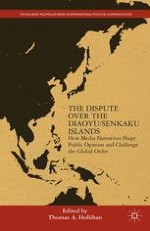2014 | Buch
The Dispute Over the Diaoyu/Senkaku Islands
How Media Narratives Shape Public Opinion and Challenge the Global Order
herausgegeben von: Thomas A. Hollihan
Verlag: Palgrave Macmillan US
Buchreihe : The Palgrave Macmillan Series in International Political Communication
